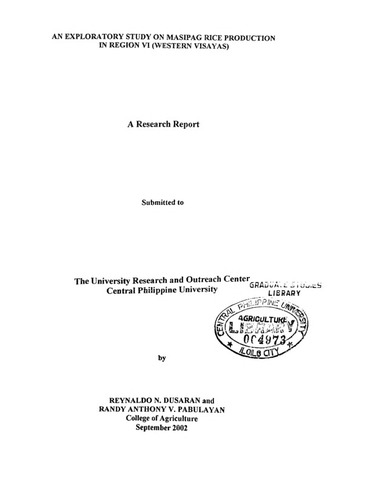An exploratory study on MASIPAG rice production in Region VI (Western Visayas)
| dc.contributor.author | Dusaran, Reynaldo N. | |
| dc.contributor.author | Pabulayan, Randy Anthony V. | |
| dc.coverage.spatial | Western Visayas | en_US |
| dc.date.accessioned | 2021-05-28T08:49:19Z | |
| dc.date.available | 2021-05-28T08:49:19Z | |
| dc.date.issued | 2002-09 | |
| dc.identifier.citation | Dusaran, R. N. & Pabulayan, R. A. V. (2002). An exploratory study on MASIPAG rice production in region VI (Western Visayas) (Research report). Jaro, Iloilo City: University Research Center, Central Philippine University. | en_US |
| dc.identifier.uri | https://hdl.handle.net/20.500.12852/922 | |
| dc.description | Abstract only | en_US |
| dc.description.abstract | This exploratory study was conducted to understand the present status of MASIPAG rice production in Western Visayas. This specifically described the profile of MASIPAG rice farmers, their farms, common rice selections used, production and marketing, problems encountered and suggestions/recommendations of MASIPAG farmers. The data for this study were gathered from 99 MASIPAG rice farmers in Antique, Aklan, Iloilo and Negros Occidental using a structured survey instrument. Focus group discussion was also used to complement the survey data. The findings of the study revealed that MASIPAG rice production is widely predominant in Negros Occidental compared with other provinces in the region. This is generally carried out by married men who were between 31 to 50 years of age. MASIPAG rice farmers were mostly owners of their farms with an average farm holdings of 1.5 ha, half of which is planted with MASIPAG rice. Their farms were generally rolling in topography and are rainfed. Aside from rice, most MASIPAG farmers are growing sugarcane or corn and vegetables. Most of the respondents have started adopting MASIPAG rice before the year 2000 after they were oriented and conducted a trial farm. They find the MASIPAG rice production technology as less expensive, particularly on fertilizer and chemicals, and environment friendly. The same reasons have influenced almost all of the respondents to continue planting MASIPAG rice. The respondents were planting a wide variety of MASIPAG rice selections but the most common and the most preferred are the Red Borong and the 5AG because of their high yielding and good eating quality. The area planted to MASIPAG as well as the level of production generally decreases during the second cropping as well as the level of production. Production costs among MASIPAG farmers was generally less then P 3,000.00 but the level of production was also relatively low. A limited proportion of respondents marketed some of their produce, generally not more than 20 cavans, as milled rice direct to consumers at a price of not more than P 400.00 per cavan. Since the respondents were not using chemicals, they consider pests as their major problem. They suggested the need to produce good quality seeds with good eating quality and resistance to pests. They also advise farmers to have patience in restoring the quality of their soil. The above findings imply that more efforts have to be made in other provinces in the region to encourage farmers to shift to MASIPAG rice production. The Negros experience should be documented and may be used as basis for intervention in other areas. The above typology of MASIPAG rice farmers can be used as basis in targeting prospective farmers to go into MASIPAG rice culture. Their reasons for adopting MASIPAG can be used to encourage target farmers to adopt MASIPAG rice culture and in the orientation, the above reasons have to be highlighted. The wide variety of selections planted by the farmers is consistent with the recommended practice of MASIPAG, but if given a choice, this finding also show that farmers prefer certain selections over other selections because of certain qualities, particularly, high yield and good eating quality. These popular and preferred selections can be tested in other areas and can serve as basis for commercial production. Low level of production particularly in the second cropping is expected since most of the farms are rainfed. It therefore implies that it is practical and sound for farmers to plant rice only on the first cropping and plant other crops for the succeeding croppings. This is further supported by the limited volume of production for marketing and thus, the marketing system is still not formalized, particularly, pricing. This also suggests research along this line. The suggestion of farmers for the production of good quality seeds with certain desired characteristics suggests breeding and selection of MASIPAG selections that will suit the above desired characteristics of seeds by farmers. This also suggests characterization of popular and preferred selections as basis for trial and adoption of farmers. | en_US |
| dc.format.extent | x, 44 leaves | en_US |
| dc.language.iso | en | en_US |
| dc.publisher | Central Philippine University | en_US |
| dc.rights | Attribution-NonCommercial-NoDerivs 3.0 Philippines | * |
| dc.rights.uri | http://creativecommons.org/licenses/by-nc-nd/3.0/ph/ | * |
| dc.subject.ddc | GSL 630.72 D94 | en_US |
| dc.subject.lcsh | Rice | en_US |
| dc.subject.lcsh | Rice farmers | en_US |
| dc.subject.lcsh | Rice farming | en_US |
| dc.subject.lcsh | Rice--Yields | en_US |
| dc.subject.lcsh | Rice--Varieties | en_US |
| dc.subject.lcsh | Philippines--Western Visayas | en_US |
| dc.title | An exploratory study on MASIPAG rice production in Region VI (Western Visayas) | en_US |
| dc.title.alternative | An exploratory study on MASIPAG rice production in Region 6 (Western Visayas) | en_US |
| dc.type | Technical Report | en_US |
| dcterms.accessRights | Limited public access | en_US |
| dc.description.bibliographicalreferences | Includes bibliographical references | en_US |
| local.subject.scientificname | Oryza sativa | en_US |
Files in this item
This item appears in the following Collection(s)
-
Research reports [167]



